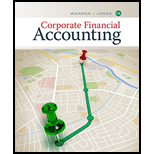
A.
Bonds Payable: Bonds payable are referred to long-term debts of the business, issued to various lenders known as bondholders, generally in multiples of $1,000 per bond, to raise fund for financing the operations.
Discount on bonds payable: It occurs when the bonds are issued at a low price than the face value.
Effective-interest method of amortization: It is an amortization model that apportions the amount of bond discount or premium based on the market interest rate.
Present Value: The value of today’s amount expected to be paid or received in the future at a compound interest rate is called as present value.
To calculate: The amount of cash proceeds (present value) from the sale of the bonds.
B.
To calculate: The amount of discount to be amortized for the first semiannual interest payment period.
C.
To calculate: The amount of discount to be amortized for the second semiannual interest payment period.
D.
The amount of bond interest expense for first year.
Trending nowThis is a popular solution!

Chapter 11 Solutions
Corporate Financial Accounting
- General accounting questionarrow_forwardNeed help with this question solution general accountingarrow_forwardBlockbuster Co is building a new state of the art cineplex at a cost of $3,500,000.They received a capital investment of $1,500,000. The remainder of funds will haveto be borrowed so they decided to issue bonds. They have issued 10.5%, 5-yearbonds. These bonds were issued on January 1st, 2020, and pay semi-annual intereston July 1st and January 1st. The bonds yield 10%. The year end is December 31starrow_forward
- Hi expert please give me answer general accounting questionarrow_forwardGeneral Accountingarrow_forwardRequired Determine whether the following items included in Wong Company’s January Year 1 bank reconciliation will require adjusting or correcting entries on Wong’s books. When an entry is required, record it in general journal format. Note: If no entry is required for a transaction or event, select "No journal entry required" in the first account field. Service charges of $50 for the month of January were listed on the bank statement. The bank charged a $250 check drawn on Wing Restaurant to Wong’s account. The check was included in Wong’s bank statement. A check of $62 was returned to the bank because of insufficient funds and was noted on the bank statement. Wong received the check from a customer and thought it was good when it was deposited into the account. A $990 deposit was recorded by the bank as $980. Four checks totaling $810 written during the month of January were not included with the January bank statement. A $75 check written to OfficeMax for office supplies was…arrow_forward
- Total assets at the year end?arrow_forwardPlease give me true answer this financial accounting questionarrow_forwardcritically analyze the effectiveness of the tax system in Jamaica with a brief history of the tax system highlight the different types of taxes used in the country and identify and discuss 4 problems with the Jamaican tax system.arrow_forward
- Solve my problemarrow_forwardSolution of all problemsarrow_forwardJones Manufacturing Co. Ltd. makes a product by way of three consecutive processes. Inspection takes place during the processing operation, at which point bad units are separated from good units and sold as scrap at $20 each. Normal losses are estimated to be 5% of input during the period. The following data relates to process 2 for the month of October. During October, 20,000 units valued at $400,000 were transferred from process 1 to process 2. Other costs incurred during the month were: Direct material added Direct labour Production overheads $272,000 $254,000 $ 120,400 At inspection, 3000 units were rejected as scrap. These units had reached the following degree of completion: Transfer from process 1 Direct material added Conversion costs 100% 80% 50% Work-in-progress at the end of October was 4,000 units and had reached the following degree of completion: Transfer from process 1 Direct material added 100% 60% 40% Conversion costs There were no unfinished goods in process 2 at the…arrow_forward

 AccountingAccountingISBN:9781337272094Author:WARREN, Carl S., Reeve, James M., Duchac, Jonathan E.Publisher:Cengage Learning,
AccountingAccountingISBN:9781337272094Author:WARREN, Carl S., Reeve, James M., Duchac, Jonathan E.Publisher:Cengage Learning, Accounting Information SystemsAccountingISBN:9781337619202Author:Hall, James A.Publisher:Cengage Learning,
Accounting Information SystemsAccountingISBN:9781337619202Author:Hall, James A.Publisher:Cengage Learning, Horngren's Cost Accounting: A Managerial Emphasis...AccountingISBN:9780134475585Author:Srikant M. Datar, Madhav V. RajanPublisher:PEARSON
Horngren's Cost Accounting: A Managerial Emphasis...AccountingISBN:9780134475585Author:Srikant M. Datar, Madhav V. RajanPublisher:PEARSON Intermediate AccountingAccountingISBN:9781259722660Author:J. David Spiceland, Mark W. Nelson, Wayne M ThomasPublisher:McGraw-Hill Education
Intermediate AccountingAccountingISBN:9781259722660Author:J. David Spiceland, Mark W. Nelson, Wayne M ThomasPublisher:McGraw-Hill Education Financial and Managerial AccountingAccountingISBN:9781259726705Author:John J Wild, Ken W. Shaw, Barbara Chiappetta Fundamental Accounting PrinciplesPublisher:McGraw-Hill Education
Financial and Managerial AccountingAccountingISBN:9781259726705Author:John J Wild, Ken W. Shaw, Barbara Chiappetta Fundamental Accounting PrinciplesPublisher:McGraw-Hill Education





